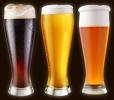
Part of Beer Quest’s mission is to bring awareness to a wider public of good beer and beer knowledge. Part of this is educating all our friends on the science, artistry and people behind great beer. To begin this beerducation crash course, let’s get into the ingredients. We will cover the four primary ingredients of beer, being malt, hops, yeast and water in a series of ongoing segments, beginning with malt.
The malt is the base of the beer and its source of the sugar that the yeast consumes and converts into alcohol. It also can provide a myriad of flavors and add to body and head retention (i.e. long lasting foam). The malt comes from barley grain which is mostly cultivated for it use in producing beer and liquor, though it is also used for animal feed and occasionally other examples of human consumption. But today (and for me, most days) it’s just all about the beer.
To prepare the malt the barley grain it is first steeped in water. The purpose of this is to initiate germination, the sprouting of the embryonic plant in the kernels which are used for beer. This prepares the starches and enzymes but the process needs to be stopped before they fully germinate and sprout. To put a halt on the process the malt is dried by kilning, or baking it, at different temperatures. The length of the steeping process and kilning temperature determines the characteristics of the malt. For example, a pilsner malt that is lightly roasted will impart biscuit flavors while a heavily kilned chocolate malt will produce bacon-like flavors.
Nah, I’m messing with you. Chocolate malt will produce chocolate flavors.
The malt is the first ingredient, along with water, used in the brewing process. The malt grain is steeped again in waters of various temperatures to reactivate the enzymes and convert its starches into sugars. It is mostly kept around 154 degrees Fahrenheit at this time, but slightly varying the temperature will also impart different results. This is called mashing and the use of different temperatures during the mashing process is called a mash schedule. The final product of this is the wort, a syrupy liquid consisting of the extracted sugars. Eventually, with a couple more steps and a few more ingredients, it will become…beer!
The malt is responsible for the sweet, grainy and toasted flavors of a beer. In long, it can provide a whole myriad of flavors that can include bready, biscuit, chocolaty, toffeeish, espresso or coffee-like, caramel and more. The fermentable sugars come from the malt as well and a beer made with more base malt will produce a beer with a higher ABV (with the proper yeast, of course). One thing to keep in mind though is that some malts are included not to produce fermentable sugar, but impart other qualities such as flavor, thicker body, improved head retention and color. Crystal malts for example impart darker colors and additional body and head retention, but lack in fermentable sugar. Malt also gives beer its color, with a darker malt producing darker colors, as well as different flavors. The Standard Reference Method, or SRM, is a numbered system to define the color of a beer with a higher number representing a darker beer. Various extracts are available on the market for home brewing.
Well I hope you enjoyed that and maybe even learned something new. Keep an eye out for the next part in our series on beerducation on those flowery, fruity heroic natural preservatives, Hops!

No comments:
Post a Comment